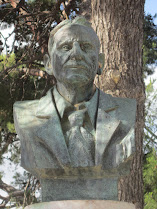Many years ago, I read a novel about treasure found in a cave on Crete; there was a connection with World War II and spies as far as I can remember. I have no idea of the title of the book or the name of the author, but it led me on a journey.
I learned of John Devitt Stringfellow Pendlebury, a British
archaeologist who worked in Crete at Knossos, and wrote a handbook called ‘The
Palace of Minos Knossos.’ Because Pendlebury explored all over Crete and knew
it so well, he worked for British Intelligence in World War II, and was shot as
a spy by German soldiers on Crete in 1941.
Pendlebury had worked at Knossos with Arthur Evans, another
British archaeologist. The first digs at the site occurred in 1878, carried out
by a resident of the nearby city of Heraklion, Minos Kalokairinos. Evans saw
Knossos for the first time in 1894. He purchased a tract of land that included
the site of Knossos, in 1899. His work there became controversial because he
not only excavated, but rebuilt parts that he feared would disintegrate if he
didn’t preserve them in some way. Evans build the Villa Ariadne in 1906, near
the palace at Knossos, and it became a home for archaeologists who worked at
the site. Pendlebury was for a time, curator at Knossos and he and his wife lived
on the Villa site.
I read as much as I could about Evans and the work at Knossos. Someday, I thought I would go there.
In 2013 this dream came true. I travelled to Greece,
staying in Athens briefly to do some sightseeing, and then moving on to Loutro,
Crete, to take a writing workshop. When that concluded, I took a bus to
Heraklion to stay for a few days. From there I took a day trip to Knossos. I
loved the place, and despite the hordes of tourists, I found peaceful places to
sit and think about the site.
“Knossos is 5 kilometers southeast of Heraklion, on the
hill of Kephala, and west of the river Kairatos. This advantageous location, which
controlled one of the most fertile regions in Crete, was to become the heart of
the Minoan civilization, considered to be the first in Europe. … The terms
Minoan and Minoans were coined by the founder of Minoan archaeology, Sir Arthur
Evans, from the name of Minos, who according to ancient myths was the king of Crete.
… The palace of Knossos was the largest and most splendid in the Minoan world.
It was nearly square in plan and had over 1,500 rooms arranged on 3 or 4 floors.
Its intricate plan probably gave rise to the later myth about the Labyrinth at
Knossos.” – from ‘Knossos, A New Guide to the Palace of Knossos’ by George Tzorakis,
archaeologist.
Photo of Queen's Megatron at Knossos.
My father had been briefly stationed on Crete as a young
German soldier before being shipped on to North Africa. He told of later meeting,
while a prisoner of war in Canada, a German General who had been captured in Crete,
and lived at the Villa Ariadne. While in Crete, I bought a book about this
exploit, described by some as one of the most daring exploits of WWII.
As a footnote, the reason the Germans decided to capture
Crete, which seems a small and insignificant island in terms of strategic
importance, was that the British had airfields there, and planes could reach
and bomb the valuable oilfields of Romania.
I will never forget that journey to Athens, Crete and Knossos,
which began with one book.
I was able to share my experiences with my father, who at
the time was still alive and hale.
Books related to this quest:
Rick Stevens Pocket Athens
A Handbook to the Palace of Minos Knossos by J.D.S.
Pendlebury
The Villa Ariadne by Dilys Powell
Knossos, A New Guide to the Palace of Knossos
by George Tzorakis
Crete on the Half Shell, A Story About an Island, Good Friends, and Food by Byron Ayanoglu



Very interesting how this story weaves back to your father, WWll, and your travels to Greece.
ReplyDelete